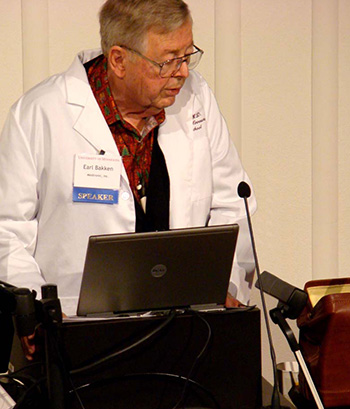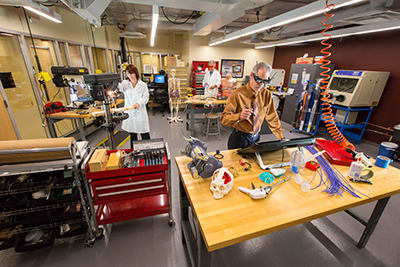|
Atlas of Human Cardiac Anatomy (2000)
The Atlas of Human Cardiac Anatomy is a free, publicly accessible interactive educational site created and maintained by the Visible Heart® Laboratory at the University of Minnesota in collaboration with Medtronic, Inc. This site features images created from the Visible Heart® project, and provides a novel educational tool which allows for viewing functional human cardiac anatomy from within.

Figure 11. Earl Bakken, the founder of Medtronic Inc., received an honorary MD degree from the University of Minnesota in 2007. He is shown here with his MD white coat and medical bag, presenting his historic prospective lecture at the first Bakken Surgical Device Symposium, hosted by the Department of Surgery at the University of Minnesota on December 13, 2007.
We have created a library of short video clips to allow you to visualize the beating human heart, valve actions, contractions of atria and ventricles, and the architecture of the heart as it functions. The video clips include those from over 60 human hearts that have been reanimated to date, as well as still images from additional human hearts that were perfusion fixed, that is, they were preserved to maintain their shape at the end stages of filling.
Human hearts for this project were obtained as generous gifts from LifeSource Organ and Tissue Donation (St. Paul, Minnesota) and the Anatomy Bequest Program of the University of Minnesota. This research is made possible due to the generous gifts of individuals whose hearts have been donated for research purposes. Their final act of generosity will enhance understanding of the inner workings of the human heart and contribute to lifesaving advances in cardiac medicine.
Bakken Surgical Device Symposia (2007)
In December 2007, the University's Department of Surgery hosted the first annual Bakken Surgical Device Symposium to celebrate the legacy of Earl Bakken (Figure 11) and the wearable, battery-powered pacemaker. Since its inception, this symposium has focused on various topics related to cutting-edge medical devices including:
- The Pacemaker: Past, Present, and Future (2007)
- Cardiac Valves: Past, Present, and Future (2008)
- Minimally Invasive Cardiac Surgery (2009)
- Heart Failure (2010)
- Recent Advances in Cardiac Devices and Procedures (2011)
- Innovations in Cardiovascular Therapy (2012)
- The Evaluation, Management and Long-term Follow-up of Children with Congenital Heart Disease (2013)
- Advances in Congenital and Adult Heart and Lung Transplantations (2014)

Figure 12. Medical Devices Center at the University of Minnesota.
Medical Device Center (2008)
Under the direction of Professor Arthur Erdman, the Medical Devices Center (MDC) (Figure 12) was established by the University of Minnesota to strengthen interdisciplinary medical device research amongst faculty in the Academic Health Center and the College of Science and Engineering. The MDC recently opened a new core facility, which includes: 1) a computer aided design (CAD)/precision instrumentation laboratory with 3D printing; 2) an electronic fabrication laboratory; 3) a mechanical prototyping facility; 4) a testing room-wet laboratory; 5) an anatomy-physiology SimPortal laboratory; and 6) a multipurpose room for modeling, assembly, demonstrations, or conferences [11]. The center supports an Innovation Fellows Program to recruit and hire individuals across the medical engineering and clinical disciplines to form cross-functional teams that aim to develop novel medical technologies.
The MDC, in collaboration with Professor Daniel Keefe from the Department of Computer Sciences and various corporate collaborators, has developed a Virtual Prototyping Lab with the goal of simulating the placement of existing or novel device concept within virtual anatomies (www.mdc.umn.edu/mdc/vrlab). Further support is provided by the Minnesota Supercomputing Institute that provides access to high-performance advanced computational resources and user support to facilitate cutting-edge research in all disciplines, as well as promote technology transfer through the interchange of ideas in the field of supercomputing research. Researchers have ready access to informatics, visualization, and application development services (www.msi.umn.edu) [12]. |


